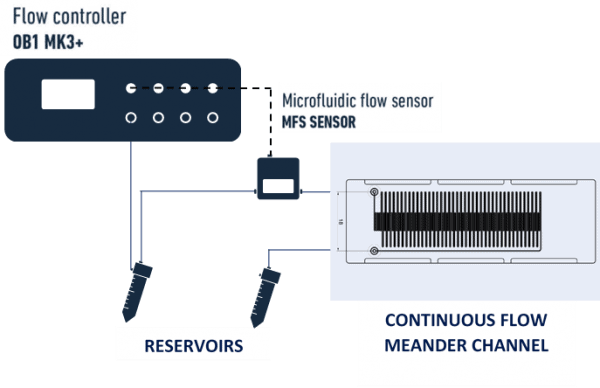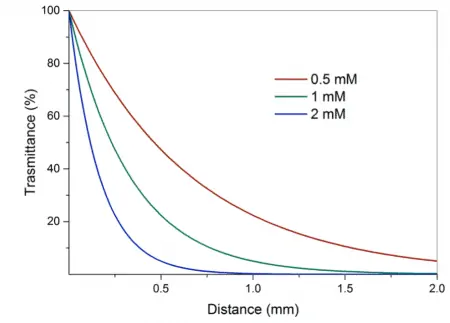Flow Photochemistry Instrument Pack
All required parts. Quick set-up. Easy to use
Long fluid path length for high residence time reactions
100 µm channel depth for efficient irradiation
Standard microscope slide format
Microfluidic continuous flow photochemistry pack
The microfluidic flow photochemistry Pack utilizes the versatile meander channel chip, providing a long fluid path distance ideal for photochemical reactions. There is no need for meters of tubing; this chip packs almost two meters of channel length into the size of a microscope slide!
Based on the high-accuracy OB1 flow controller (Elveflow) and a meander channel chip, this plug-and-play solution contains all the required parts to establish flow photochemistry reactions quickly.
The standard continuous flow photochemistry pack contains a single pumping channel to push the reaction fluid through the meander channel chip, creating a long fluid path and residence time.
The short 100 µm channel depth allows fluid irradiation to occur far more efficiently than batch methods or tubing-based microreactors.
Flow rates can be measured thanks to flow rate sensors (MFS or BFS series, Elveflow). Fix a light source above the channel, press a button to start pumping, and conduct the flow photoreactions. This experiment is both easy to set up and efficient.
Flow photochemistry pack setup
This pack guarantees a good compatibility between its components that are piloted by a single software. The provided instruments are easy to use with complete user guides and set of accessoiries.

A typical flow photochemistry pack contains:
- OB1 flow controller (Elveflow)
- 1x flow sensor (MFS or BFS, Elveflow)
- 2 x 15 mL reservoirs
- Microfluidic chips from microfluidic ChipShop
- All necessary accessories: tubing, connectors, filters, etc…
- Command and automation software Elveflow)
Microfluidic continuous flow photochemistry principle
The meandering channel that can be included in the flow photochemistry pack, also known as a serpentine channel, is a simple channel designed to take advantage of the microfluidic chip format to fit a long fluid path length into a small area.
With a long fluid path length, long residence times when reagents are inside the microreactor are made possible while maintaining moderate to high flow rates for high throughput reactions. This format has enabled a wide variety of flow chemistry reactions [1–4], particularly photoreactions [5–7], showing significantly improved reaction rates compared to in batch.
References
1. K. S. Elvira, X. C. i Solvas, R. C. R. Wootton, and A. J. DeMello, “The past, present and potential for microfluidic reactor technology in chemical synthesis,” Nat. Chem., vol. 5, no. 11, pp. 905–915, 2013.
2. R. Porta, M. Benaglia, and A. Puglisi, “Flow Chemistry: Recent Developments in the Synthesis of Pharmaceutical Products,” Org. Process Res. Dev., vol. 20, no. 1, pp. 2–25, 2016.
3. D. M. Ratner, E. R. Murphy, M. Jhunjhunwala, D. a Snyder, K. F. Jensen, and P. H. Seeberger, “Microreactor-based reaction optimization in organic chemistry–glycosylation as a challenge.,” Chem. Commun. (Camb)., 2005.
4. J. S. Moore and K. F. Jensen, “Automated Multitrajectory Method for Reaction Optimization in a Microfluidic System using Online IR Analysis,” Org. Process Res. Dev., vol. 16, no. 8, pp. 1409–1415, Aug. 2012.
5. T. Fukuyama, Y. Hino, N. Kamata, and I. Ryu, “Quick Execution of [2+2] Type Photochemical Cycloaddition Reaction by Continuous Flow System Using a Glass-made Microreactor,” Chem. Lett., vol. 33, no. 11, pp. 1430–1431, Nov. 2004.
6. R. A. Maurya, C. P. Park, and D.-P. Kim, “Triple-channel microreactor for biphasic gas–liquid reactions: Photosensitized oxygenations,” Beilstein J. Org. Chem., vol. 7, pp. 1158–1163, Aug. 2011.
7. C. P. Park, R. A. Maurya, J. H. Lee, and D.-P. Kim, “Efficient photosensitized oxygenations in phase contact enhanced microreactors,” Lab Chip, vol. 11, no. 11, p. 1941, 2011.
Why use microfluidics for flow cytochemistry?
Working with microfluidics for chemistry is a way to decrease significantly the amount of reagents used per experiment, which can lower cost and waste output.
Moreover, microfluidic precision allows for the rapid fine-tuning of reaction parameters, allowing for efficient reaction optimization at reduced time and reagent consumption compared to batch methods.
The small light path distances in microfluidic channels allow for solution irradiation with high homogeneity. Inhomogeneity in irradiation is a common problem in batch photochemistry (see the Figure below) due to millimeter-scale light paths. Greater irradiation homogeneity from flow photochemistry can allow higher throughput reactions and more excellent reaction selectivity.
Micrometer scales in microfluidic chips also allow reactions with greater thermal homogeneity thanks to the high surface-area-to-volume ratios. This will significantly increase the heat transfer in microreactors, which can also help improve reaction selectivity.
Finally, microfluidic chip reactors allow for significant reaction path length while maintaining a small footprint compared to a comparable tubing-based microreactor, much less batch reactors.

1. Cambié, D., Bottecchia, C., Straathof, N. J. W., Hessel, V., & Noël, T. (2016). Chemical Reviews, 116, 17, 10276–10341.
Customize your flow photochemistry pack
The microfluidic flow photochemistry pack can be exceedingly personalized depending on your specific application. For example, supplementary pumping channels for the OB1 flow control pump and flow rate sensors can be added to the pack to inject different solutions inside the microfluidic chip.
Coriolis flow sensors can also be chosen to replace the MFS to improve the flow rate sensing and thus its control inside the microfluidic chip even more.
The meander channel chip provided by Microfluidics ChipShop is available in Cyclo Olefin Copolymer (COC): Channel depth: 100 µm; channel width: 200 µm; channel length: 1,879 mm; number of cycles: 41; lid thickness 125 µm.
COC is a solvent-resistant plastic that can handle aqueous solutions (including acids and bases) and polar organic solvents. It also possesses excellent optical properties, with high optical transmission down to approximately 300 nm.
If you’re unsure about the suitability of the meander chip reactor for your application, contact one of our experts to ensure that the flow photochemistry pack matches your specifications!
– Check our other Packs for various applications –
Can I order a pack?
A Pack can be available under certain conditions. Since Packs are products that are still being developed, we have a few eligibility criteria to maximise their success rate. A discussion with our experts is needed to determine your specific needs in order to offer you a personalized response.
How can we help in your experiment?
This Pack’s applications are still under development, so we are not able to give you the tips or troubleshooting advice that we usually give in our user guides and application notes for the possible challenges you could face for a specific application experiment. That being said, we can always guarantee reliable and high precision microfluidic flow control. Our microfluidic instruments are high performance, versatile and user-friendly. Our experts will bring support and expertise during the setup and the implementation of the pack.
Can a pack be customized based on my specific application?
Yes! Our experts will establish which instruments are best suited for your application, such as the type of flow sensor or the number of flow controller channels you need to perform your experiment. Send us a message at: innovation@microfluidic.fr
Can I buy individual instruments?
You can order the instruments on the product section of our website.